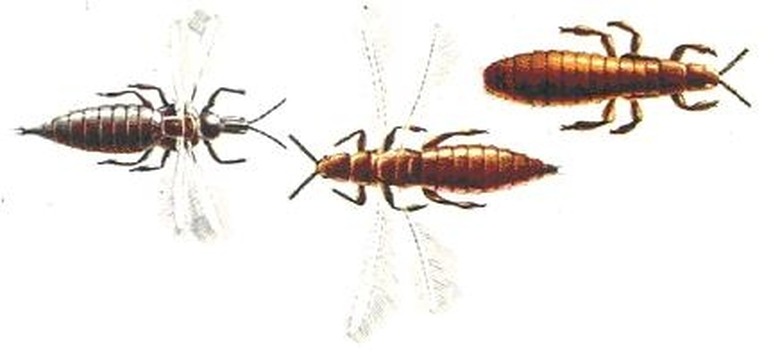The Life Cycle Of Thrips
Thrips, commonly known as Thunder Flies or Thunder Bugs, are tiny insects that range in length from one twenty-fifth of an inch to one-eighth of an inch. They have short antennae and short legs. Usually black, yellow or brown, they may have red, black or white markings. Some have wings.
Within the U.S. and Canada, there are 264 species of thrips, according to the University of Florida Entomology Department. Most feed on plants, but some are predators. Some thrips are considered pests while others are beneficial insects that eat mites, other insects, pollen and fungal spores.
Despite the many types of thrips, most follow a similar life cycle, going through metamorphosis in the stages of egg, nymph, pupa and adult.
Egg
Egg
The female thrip will deposit her eggs in the slits she creates in leaf tissues using her ovipositors. The eggs are kidney-shaped and large in comparison to the thrip. Each female thrip will lay 25 to 50 eggs, which will begin hatching in as few as two days, depending upon the species.
Nymph
Nymph
A nymph emerges from each egg. The immature thrip looks like the adult. However, even in winged species, the nymph is wingless. The nymphs are more lightly colored than their adult counterparts. During this stage of development, the thrip is feeding and will molt at least twice, depending upon the species.
Prepupa
Prepupa
During the prepupa stage, the nymph's cuticle is separated from the hypodermis, but the cuticle is not yet cast off. During this stage the nymph does not eat and drops from its host plant to the soil or leaf debris below. In a few species, prepupa may take place on the host plant. Depending upon the species, the prepupation may take only a few hours or up to several days.
Pupa
Pupa
Although this is commonly referred to as the pupa stage, according to the University of California's Statewide Integrated Pest Management Program, thrips do not have a true pupa stage as most insects do.
The stage of development takes place in earthen cells or cocoons beneath the soil, or in some species, on the host plant. From this final stage of development, an adult thrip will emerge.
Adult
Adult
The complete life cycle can be completed in as little as two weeks, depending upon environmental conditions. The cycle may repeat itself as often as eight times in one year, depending upon the species.
In the adults, if the species includes males, the male thrip is usually smaller than the female. In some thrip species, parthenogenesis occurs. This means reproduction takes place without fertilization by a male.
The adult thrips will feed by puncturing their host plant and sucking out the cells.
Cite This Article
MLA
Foster, Bethney. "The Life Cycle Of Thrips" sciencing.com, https://www.sciencing.com/the-life-cycle-of-thrips-12219099/. 25 September 2009.
APA
Foster, Bethney. (2009, September 25). The Life Cycle Of Thrips. sciencing.com. Retrieved from https://www.sciencing.com/the-life-cycle-of-thrips-12219099/
Chicago
Foster, Bethney. The Life Cycle Of Thrips last modified March 24, 2022. https://www.sciencing.com/the-life-cycle-of-thrips-12219099/
